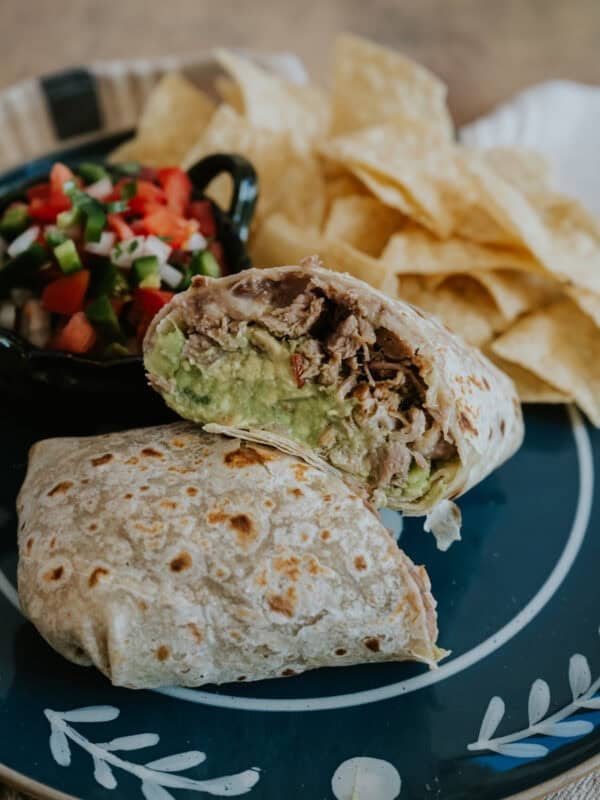Té de Manzanilla (Chamomile Tea)
5
Updated Jun 18, 2024, Published Mar 30, 2014
This post may contain affiliate links. Please read our disclosure policy.
My Abuela’s recipe for Té de Manzanilla is nothing short of magical when you’re feeling under the weather. This manzanilla tea is my go-to remedy for upset tummies and frayed nerves, but it’s lovely even if you’re feeling fine and just want a cozy cup of tea!

When I was a little girl, my Mom would take me to my abuela’s house—not the doctor—whenever I got sick. She had all kinds of holistic remedies up her sleeve: té de oregano, té de canela, homemade tinctures and salves, and plenty of Vick’s Vapo Rub. She lived to be 98, so she obviously was on to something!
This manzanilla tea was just one of my abuela’s remedios, but it works so well, I make it all the time. So, the next time you need a moment of peace or a natural way to soothe your body and mind, reach for a warm cup of manzanilla tea and let its gentle magic work wonders. It always makes me feel better!
What is Manzanilla?
Manzanilla is the Spanish name for chamomile, a potent herbal remedy that has been cherished for centuries. Chamomile is a plant with small flowers with white petals, similar to daisies, which is used mainly for medicinal and therapeutic purposes. Its name is due to its aroma—reminiscent of an apple.
Manzanilla (chamomile) tea is a staple in many Latin households, and is often used as a natural remedy for a variety of ailments. It is renowned for its calming effects, making it a go-to drink before bedtime. Manzanilla tea also aids digestion, reduces pain and inflammation, and alleviates cold and allergy symptoms.

Why You’ll Love This Té de Manzanilla Recipe
- It’s an all-natural, pharmaceutical-free remedy for everything from menstrual cramps and tummy aches to sniffles and sleeplessness.
- You only need 3 ingredients and 5 minutes to make it.
- It’s gentle enough that I even used to give it to my kiddos in their baby bottles.
Ingredients & Substitutions
The complete list of ingredients, quantities, and instructions can be found in the printable recipe card below.

- Fresh or Dried Chamomile Flowers – My grandma grew her own chamomile. Of course, you’re welcome to use a chamomile tea pouch instead!
- Water – If possible, use filtered water for the best taste. No filter? No problem! Simply boil your tap water for 15 minutes or let it sit out on the counter, uncovered, for 12-24 hours to give the chlorine time to evaporate.
- Honey – This natural sweetener does more than add delicious flavor; it has its own host of health benefits. It is excellent for soothing sore throats and easing congestion, plus its antibacterial and antifungal properties make it wonderful for battling various illnesses.
How to Make Manzanilla Tea
Making manzanilla tea is very simple.
Step 1: Boil & Steep. Bring 3 cups water to a boil, pour in the chamomile, cover and let steep 5 minutes.
Step 2: Strain & Serve. Strain the flowers, then add honey to taste. Enjoy!

Serving & Topping Suggestions
- For tummy aches, vomiting, and diarrhea.
- For improved sleep.
- Enjoy a mug of this cozy té de manzanilla with glazed lemon cookies or a slice of lemon berry spring fling cake.
Expert Tips & Tricks
Making a perfect cup of manzanilla tea is a delightful ritual. Here are some tips to help you brew a soothing and flavorful mugful:
- Fresh or tea bag: Start with high-quality fresh or dried chamomile flowers. Look for organic options to ensure that your tea is free from pesticides and additives. If you prefer tea bags, select those that contain pure chamomile without any added fillers.
- Prevent bitterness: Use water that is just below boiling point, around 200°F (93°C). Boiling water can scorch the delicate flowers, leading to a bitter taste. Let the water sit for a minute after boiling before pouring it over the chamomile.
- Steep the chamomile flowers for about 5 to 7 minutes. If you prefer a stronger tea, you can steep it a bit longer than 5 minutes, but be cautious not to overdo it—it can become bitter.
- Strain: If you’re using loose chamomile flowers, try placing them in a tea infuser or tea bag to make it easier to strain.
- Hot or cold: I prefer hot manzanilla tea, but you can also enjoy it cold. For iced chamomile tea, brew it a bit stronger (i.e. use more chamomile flowers) and let it cool before pouring over ice. Add a slice of fresh citrus fruit for a refreshing summer drink.
- Enjoy: Part of the charm of manzanilla tea is its calming effect. Take a moment to sit back, relax, and savor the gentle aroma and flavor of your freshly brewed tea. It’s the perfect time to unwind and enjoy a peaceful break.
Frequently Asked Questions
Chamomile (a.k.a. manzanilla) is excellent for treating a variety of illnesses. I reach for it when I’m feeling stressed out, dealing with insomnia, or have tummy troubles, a cold, or allergies.
Yep! When my babies would get the sniffles, I’d brew up a mugful of manzanilla tea, then let it cool down until it was comfortable to sprinkle on my forearm and put it in a bottle. Just note that kids under 1 should not have honey, so leave that out.
More Natural Remedios Recipes
If you make this recipe, please let me know! Leave a ⭐️⭐️⭐️⭐️⭐️ rating on this recipe below and leave a comment, take a photo and tag me on Instagram with #muybuenocooking.


Chamomile Tea (Té de Manzanilla)
Ingredients
- 1 tablespoon fresh chamomile flowers or 1 teaspoon dried or chamomile tea pouch
- 3 cups water
- Honey
Instructions
- Bring 3 cups water to a boil, pour in the chamomile, cover and let steep 5 minutes. Strain and serve.
- Add honey to taste.
Notes
- Fresh or tea bag: Start with high-quality fresh or dried chamomile flowers. Look for organic options to ensure that your tea is free from pesticides and additives. If you prefer tea bags, select those that contain pure chamomile without any added fillers.
- Prevent bitterness: Use water that is just below boiling point, around 200°F (93°C). Boiling water can scorch the delicate flowers, leading to a bitter taste. Let the water sit for a minute after boiling before pouring it over the chamomile.
- Steep the chamomile flowers for about 5 to 7 minutes. If you prefer a stronger tea, you can steep it a bit longer than 5 minutes, but be cautious not to overdo it—it can become bitter.
- Strain: If you’re using loose chamomile flowers, try placing them in a tea infuser or tea bag to make it easier to strain.
- Hot or cold: I prefer hot manzanilla tea, but you can also enjoy it cold. For iced chamomile tea, brew it a bit stronger (i.e. use more chamomile flowers) and let it cool before pouring over ice. Add a slice of fresh citrus fruit for a refreshing summer drink.
- Enjoy: Part of the charm of manzanilla tea is its calming effect. Take a moment to sit back, relax, and savor the gentle aroma and flavor of your freshly brewed tea. It’s the perfect time to unwind and enjoy a peaceful break.
Nutrition
Nutrition information is automatically calculated, so should only be used as an approximation.













Thank I too grew up with remedies that help whatever you were ailing with. Grandmothers had wisdom that is just not common today.
Love your blog! I thought my nana was the only one that would use marijuana and romero in alcohol, lol!
It’s been far too long since I rewarded myself with the time to fully read (and enjoy) your blog. The story of going to abuela’s house made me teary as I miss my own abuelita and the days when my sisters and I would go to her house when we were sick, too. There were a few days when I really wasn’t all that sick; I just wanted was time with my Nana. Reminiscing aside, this also inspired me to devote some space on my tiny city patio to plant a patch of Nana’s herbs. Thanks for the nudge!
When I was young my grandmother used to steep lemons with honey and sometimes a little mint from her garden. It was pure magic. I don’t know if it was its medicinal powers or just because we didn’t want another cup, but it sure helped for some reason. Thanks for sharing this little recipe with us. Have fun in Miami!
Sounds like a busy and exciting time for you, Yvette! I am excited to hear of your latest adventure. Thanks for sharing this special connection to your grandmother– what a strong and wise woman.